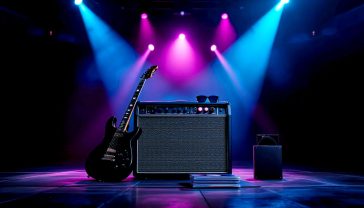The UK Guide to Tablets for Kids: A Parent’s Complete Handbook to Choosing the Right Device
Your complete guide to kids’ tablets in the UK. We cut through the jargon to help you choose, set up, and manage the perfect device for your child.

This post may contain affiliate links. If you make a purchase through these links, we may earn a commission at no additional cost to you.
Let’s be honest, the moment you hand a child a tablet, it’s like magic. Their eyes light up, tiny fingers start swiping, and suddenly you’ve got five minutes of peace to drink a hot cup of tea. But then the questions start creeping in. Is this the right tablet? Is it safe? Is it secretly turning their brain into mush, or is it a brilliant learning tool?
Welcome to the great tablet minefield. For parents across the UK, it’s a tricky landscape to navigate. On one hand, these sleek little screens are incredible gateways to learning, creativity, and entertainment. They can teach your little one the alphabet with a catchy song, let them explore the pyramids of Giza from the sofa, or help them design a digital masterpiece. On the other hand, worries about screen time, online safety, and durability are very real.
This isn’t just another tech review. This is your complete, no-nonsense guide to choosing, setting up, and managing a tablet for your child. We’ll cut through the jargon, ignore the flashy marketing, and get straight to what matters for British families. Whether you’ve got a toddler who’s just discovered CBeebies or a tween who’s desperate to join the Minecraft craze, we’ve got you covered. We’ll explore the best options on the market, from the indestructible Amazon Fire Kids tablets to the versatile iPad, and help you figure out which one is the perfect fit for your family, your budget, and your peace of mind.
So, grab that cuppa, get comfortable, and let’s dive in. By the end of this guide, you won’t just feel informed; you’ll feel confident that you’re making the best decision for your child in this digital world.
What Exactly Is a ‘Kid’s Tablet’ Anyway?
Before we start comparing models, let’s clear something up. What makes a tablet a “kid’s tablet”? Is it just a normal tablet painted in bright colours with a rubbery case? Well, sometimes, yes. But a good kid’s tablet is much more than that.
At its heart, a kid’s tablet is a device specifically designed or adapted for children. This usually means it has three key features that set it apart from the standard tablet you might use for work or browsing the news.
1. The All-Important Parental Controls
This is the big one. A proper kid’s tablet gives you, the parent, total control. Think of it as the digital equivalent of baby-proofing your house. These controls are built into the very fabric of the device, allowing you to:
- Set Strict Time Limits: You can decide not just how long they can use the tablet each day, but also when. For example, you can set it to switch off automatically an hour before bedtime or only allow games after homework is done.
- Filter Content: This is crucial. You can create a “walled garden” of apps, websites, and videos that you’ve personally approved. Anything outside this garden is completely inaccessible. This means no accidental clicks on scary YouTube videos or stumbling across inappropriate websites.
- Manage Spending: You can disable in-app purchases entirely, so you don’t get a nasty surprise on your credit card bill after your child has bought a thousand digital gems in their favourite game.
- View Activity Reports: Many kid-friendly systems let you see exactly what your child has been doing—which apps they’ve used, how long they’ve spent learning versus playing, and what they’ve been searching for.
These controls are designed to be easy for you to manage but difficult for a tech-savvy child to bypass.
2. Built Like a Tonka Toy: Durability Matters
Let’s face it, kids are not gentle with their belongings. A tablet is likely to be dropped, sat on, thrown in a backpack, and possibly even used as a makeshift dinner plate. Standard tablets with their slim glass screens don’t stand a chance.
That’s why kid’s tablets are built to survive the chaos of family life. This usually involves:
- A Chunky, Kid-Proof Case: Most dedicated kid’s tablets, like the Amazon Fire Kids range, come with a thick, bouncy case made of foam or rubber. These cases are designed to absorb impact from falls and protect the delicate screen. They often have big, easy-to-grip handles for little hands.
- A “No-Quibble” Warranty: This is Amazon’s ace in the hole. Their Fire Kids tablets come with a two-year, worry-free guarantee. If your child breaks it, Amazon will replace it, no questions asked. This peace of mind is invaluable for many parents.
3. Content That’s Made for Them
Finally, the best kid’s tablets come pre-loaded with a treasure trove of age-appropriate content. Instead of a blank slate that you have to fill with apps from a vast, overwhelming app store, these devices offer a curated experience from the moment you turn them on.
- Curated App Stores: The device will likely have its own app store filled only with kid-friendly games, books, and learning tools. You don’t have to worry that they’ll download something unsuitable.
- Subscription Services: Many models, particularly the Amazon Fire Kids, include a one-year subscription to a service like Amazon Kids+. This gives you unlimited access to thousands of books, apps, games, videos, and audiobooks from trusted brands like Disney, CBeebies, and LEGO, all carefully selected for different age groups.
So, a true kid’s tablet isn’t just about the hardware. It’s a complete package—a tough, safe, and engaging ecosystem designed to give your child a positive first step into the digital world, while keeping you firmly in the driver’s seat.
The Big Players: Who’s Who in the UK Kids’ Tablet Market?
When you start shopping for a kid’s tablet, you’ll quickly notice a few names popping up again and again. While there are lots of cheaper, lesser-known brands out there, the market is really dominated by three main contenders: Amazon, Apple, and to a lesser extent, Samsung. Each has a very different approach, and the right one for your family will depend on your budget, your tech-savviness, and what you want the tablet to be used for.
Let’s break them down.
Amazon Fire Kids Tablets: The Undisputed Champion
If there’s one device that has cornered the market for young children in the UK, it’s the Amazon Fire HD Kids tablet. Walk into any playground, and you’re bound to see these colourful, rubbery tablets in action. There’s a good reason for their popularity: they are designed from the ground up for kids and parents.
- What they are: These are modified versions of Amazon’s standard Fire tablets, but they come bundled with a kid-proof case, a two-year worry-free guarantee, and a one-year subscription to Amazon Kids+.
- The Pros:
- Incredibly Tough: The foam case is a lifesaver. These things can take a serious amount of punishment.
- The Worry-Free Guarantee: This is the killer feature. If it breaks, for any reason, Amazon replaces it. This is a game-changer for parents.
- Superb Parental Controls: The Amazon Parent Dashboard is brilliant. It’s easy to use and lets you control everything from time limits to content access with pinpoint precision.
- Amazon Kids+: The included one-year subscription is fantastic value. It offers a massive library of age-appropriate books, games, videos, and apps. It’s a safe, curated world your child can explore without you having to vet every single download.
- Affordable: Compared to an iPad, they are significantly cheaper, making them a less scary investment.
- The Cons:
- The Amazon Ecosystem: You’re locked into Amazon’s world. The app store is Amazon’s, not Google’s. This means you won’t find some popular apps, most notably YouTube and many Google apps like Google Classroom. While there are workarounds, they aren’t straightforward.
- A Bit Sluggish: Let’s be honest, these are not high-performance machines. They can be a bit slow to load apps, and the touchscreen isn’t as responsive as an iPad’s. For a young child, this is rarely an issue, but an older, more demanding user might get frustrated.
- Basic Screen and Sound: The screen resolution and speaker quality are perfectly fine for watching Peppa Pig, but they don’t compare to the premium experience of an iPad.
Best for: Toddlers and primary school children (ages 3-10). They are the perfect first tablet—safe, tough, and packed with content.
Apple iPad: The Premium All-Rounder
The iPad is the tablet everyone knows. It’s sleek, powerful, and has an incredible app store. But can it be a kid’s tablet? Absolutely, with a bit of work.
- What it is: A standard Apple iPad (usually the basic model or the iPad Mini) that you adapt for a child using Apple’s built-in parental controls and a third-party case.
- The Pros:
- Unbeatable Performance: iPads are fast, smooth, and a joy to use. The screen is bright and beautiful, and the touch response is flawless.
- The App Store: The Apple App Store is vast and contains an incredible range of high-quality educational apps, creative tools, and games. If an app exists, it’s probably on the App Store. This is crucial for older kids who might need specific apps for school.
- Longevity: An iPad will last for years and will grow with your child. A tablet that’s used for CBeebies today can be used for homework and creative projects tomorrow. It has a much longer useful life than a typical kid’s tablet.
- Creative Powerhouse: With an Apple Pencil, an iPad becomes an amazing tool for drawing, painting, and note-taking.
- The Cons:
- Price: This is the biggest hurdle. iPads are expensive. You’ll also need to buy a durable case and screen protector separately, adding to the cost.
- Fragile: Without a case, an iPad is a shattered screen waiting to happen. The cost of a screen repair can be eye-watering.
- Parental Controls Are More Fiddly: Apple’s “Screen Time” feature is very powerful, but it’s not as intuitive or user-friendly as Amazon’s Parent Dashboard. It takes more time and effort to set up correctly.
- The Open Internet: Even with controls, the iPad feels more connected to the wider internet. You need to be more vigilant to ensure your child stays within the boundaries you’ve set.
Best for: Older children (ages 8+), families already invested in the Apple ecosystem, or for sharing between parents and children. It’s a superb device if you have the budget and are willing to put in the time to set it up properly.
Samsung and other Android Tablets: The Middle Ground
Samsung, along with other manufacturers like Lenovo, produces a range of Android tablets that can be a good middle ground between the locked-down Amazon Fire and the premium iPad.
- What they are: Standard Android tablets that run on Google’s operating system. They offer a more open experience than Amazon’s Fire tablets.
- The Pros:
- Access to the Google Play Store: This is their main advantage over Amazon. You get the full range of Android apps, including YouTube, YouTube Kids, and Google’s suite of educational tools like Google Classroom.
- Flexibility and Choice: There’s a huge range of Android tablets at different price points, so you can often find one that fits your budget.
- Google Family Link: Google’s parental control app, Family Link, is very good. It lets you manage app access, set screen time limits, and even locate your child’s device.
- The Cons:
- The Setup Burden is on You: Like the iPad, you’re essentially buying a standard tablet and turning it into a kid’s device yourself. You’ll need to install and configure Family Link, find and buy a sturdy case, and curate the content yourself.
- Inconsistent Quality: The Android tablet market is a mixed bag. Cheaper models can be very slow, with poor screens and short battery life. You need to do your research to find a good one.
- No “Worry-Free” Guarantee: You’re on your own if it breaks. Standard manufacturer warranties don’t cover accidental damage.
Best for: Tech-savvy parents who want access to the full Google Play Store and are happy to do the setup themselves. They can be a great, flexible option for children who need access to specific Google services for school.
Age by Age: Matching the Tablet to Your Child
A tablet for a three-year-old is a very different beast from a tablet for a ten-year-old. The former needs to be simple and indestructible; the latter needs to be capable and flexible. Choosing the right device means thinking carefully about your child’s age, developmental stage, and how they’re likely to use it.
Here’s a breakdown of what to look for at each stage.
The Toddler and Preschool Years (Ages 3-5)
At this age, a tablet is primarily a tool for simple games, interactive stories, and watching favourite shows. The focus should be on durability, safety, and ease of use.
- Top Priority: Durability. The tablet will be dropped. It will be smeared with jam. You need a device that can withstand the rough and tumble of toddler life.
- What to Look For:
- An integrated, chunky case. This is non-negotiable. The Amazon Fire Kids tablet with its foam case is the gold standard here.
- A simple, visual interface. Your child should be able to navigate to their favourite apps just by looking at the icons. The Amazon Kids+ interface is excellent for this, with big, bright pictures.
- Pre-loaded, curated content. You don’t want to be spending hours searching for and vetting apps. A subscription service like Amazon Kids+ is ideal, as everything on it is guaranteed to be age-appropriate.
- Watertight parental controls. At this age, you want a completely walled garden. They should only be able to access what you have explicitly allowed.
- Best Bet: Amazon Fire HD 7 Kids or Fire HD 8 Kids. They tick all the boxes: they’re tough, safe, affordable, and come with a huge library of content perfect for this age group. The smaller 7-inch model is often better for very small hands.
Early Primary School (Ages 6-8)
As children start school, their needs begin to change. They’re becoming more independent, their reading skills are developing, and they might start using tablets for very simple homework or educational apps recommended by their school.
- Top Priority: A balance of fun and learning. The tablet is still a toy, but it’s also becoming a tool. The content needs to reflect this, with a good mix of educational apps, creative tools, and, of course, fun games.
- What to Look For:
- A larger, better screen. As they start to read more and play more complex games, a bigger and clearer screen is beneficial. The Fire HD 8 or 10 models are great choices.
- More sophisticated educational content. Look for apps that support the school curriculum, such as phonics and maths games. The Amazon Kids+ library adapts as your child gets older, offering more advanced content.
- Headphone jack. This is the age where you will be eternally grateful for the invention of headphones.
- Flexible parental controls. You might want to start giving them a little more freedom, perhaps by setting educational goals (e.g., “read for 30 minutes before games are unlocked”). Amazon’s Parent Dashboard allows for this.
- Best Bet: Amazon Fire HD 8 Kids Pro or Fire HD 10 Kids Pro. The “Pro” versions come with a slimmer case and a more “grown-up” looking home screen, which appeals to this age group. They still offer the same great parental controls and worry-free guarantee. An entry-level Samsung Galaxy Tab A with Google Family Link is also a solid alternative if access to the Google Play Store is important.
The Tween Years (Ages 9-12)
This is where things get serious. Tweens are more tech-savvy and their needs are much more complex. They’ll be using the tablet for school research, communicating with friends, playing sophisticated games like Minecraft and Roblox, and perhaps even exploring creative hobbies like digital art or video editing.
- Top Priority: Performance and versatility. A sluggish, locked-down kids’ tablet will no longer cut it. They need a device that can handle multitasking, run demanding apps, and connect to the wider internet (safely, of course).
- What to Look For:
- A proper operating system. This means iOS (on an iPad) or full Android (on a Samsung or Lenovo tablet). They need access to a full app store and a proper web browser for school projects.
- Good performance. A faster processor and more RAM are essential for running the games and apps this age group loves.
- A high-quality screen and camera. They’ll be watching a lot of YouTube and maybe video-chatting with family and friends. A good front-facing camera is a must.
- Keyboard and stylus compatibility. For homework and creative projects, the ability to connect a keyboard or use a stylus is a huge advantage.
- Robust but subtle parental controls. You still need control, but you need to manage it in a way that respects their growing independence. Apple’s Screen Time and Google’s Family Link are designed for this, allowing you to set limits and monitor activity without making them feel like they’re using a “baby” device.
- Best Bet: Apple iPad (9th or 10th Generation). It’s the undisputed king for this age group. It’s powerful, versatile, has the best selection of apps, and will last them well into their teenage years. If the budget is tight, a good mid-range Samsung Galaxy Tab is the next best choice, offering full access to Google’s services.
Setting Up for Success: Your 10-Step Safety Checklist
Getting the tablet out of the box is the easy part. The most important job comes next: setting it up to be a safe, positive, and productive space for your child. Don’t just hand it over and hope for the best. Taking 30 minutes to go through this checklist will save you a lot of headaches down the line.
1. Create a Child Profile (Don’t Use Your Own!). This is the most critical step. Whether you’re on an Amazon Fire, an iPad, or an Android tablet, create a separate user account or profile for your child. This allows you to customise their experience and lock down settings without affecting your own. On Amazon, this is the ‘Child Profile’. On Apple, it’s a ‘Child Account’ within your Family Sharing group. On Android, it’s a child account managed by Google Family Link.
2. Dive into the Parental Control Panel. This is your mission control. Find the parental control section (Amazon Parent Dashboard, Apple Screen Time, Google Family Link) and explore every single setting. Don’t just glance at it. Understand what each option does.
3. Set Sensible Time Limits from Day One. It’s much easier to establish rules from the start than to try and claw back unlimited screen time later. Decide on a daily limit that you’re comfortable with. A good starting point is often 1 hour on weekdays and 2 hours on weekend days, but this is a personal choice for your family. Use the settings to enforce this automatically.
4. Create a Content “Walled Garden”. Go through the list of apps and content and approve only what you want them to access. For younger kids, this might mean just a handful of trusted apps like CBeebies Playtime Island and a few downloaded videos. For older kids, you can approve specific websites for school research while blocking everything else. Be ruthless – you can always add more later.
5. Disable All In-App Purchases. Find the setting to block in-app purchases and turn it on. This simple click can save you from a shocking credit card bill when your child decides they need to buy a virtual universe of hats for their favourite character.
6. Install a Safe Browser (or Disable Browsing). For young children, it’s often best to disable the web browser entirely. They don’t need it. For older children who need it for homework, install a kid-safe browser or use the built-in filters to restrict them to an approved list of websites.
7. Review Privacy and Location Settings. Go into the main device settings and turn off location tracking for all apps that don’t absolutely need it. Review the privacy settings for each app to make sure it’s not collecting more data than necessary.
8. Have “The Talk” (The Tech Version). Sit down with your child and explain the rules. Show them how much time they have each day. Explain why certain things are off-limits. Frame it positively – this is about keeping them safe and making sure the tablet is a fun and healthy part of their life. This conversation is just as important as the technical settings.
9. Set Up a Central Charging Station… Outside the Bedroom. This is a golden rule of modern parenting. The tablet does not live in the child’s bedroom. Create a designated charging spot in a family area like the kitchen or living room. All devices go there at least an hour before bedtime. This helps with sleep hygiene and prevents late-night, unsupervised scrolling.
10. Schedule Regular Check-Ins. Your job isn’t done after the initial setup. The apps your child likes will change, their needs will evolve, and new challenges will arise. Set aside 15 minutes every month or so to review their activity reports, check their app list, and have a chat with them about what they’re enjoying and if they’ve seen anything that made them feel uncomfortable.
Setting up a tablet safely is an ongoing process, not a one-time task. By staying involved, you can ensure it remains a wonderful tool rather than a source of conflict.
Beyond the Screen: Fostering a Healthy Tech-Life Balance
The tablet is here, it’s set up, and your child loves it. Now comes the real challenge: making sure it’s just one part of a rich and varied childhood, not the main event. A healthy relationship with technology isn’t about banning screens, but about integrating them into life in a balanced and mindful way.
The Screen Time Debate: Quality Over Quantity
For years, the conversation has been dominated by one question: “How much screen time is too much?” While official guidelines (like those from the NHS) suggest limits, a more modern and helpful approach is to focus on the quality of the screen time, not just the quantity.
Think of it like a diet. 60 minutes of chomping on sweets is very different from 60 minutes of eating a balanced meal. The same is true for screens.
- Passive Consumption (The ‘Sweets’): This is mindlessly watching back-to-back YouTube unboxing videos or playing a repetitive, low-effort game. It’s fine in small doses, but it’s the tech equivalent of junk food.
- Active Creation (The ‘Balanced Meal’): This is using the tablet to create something. It could be coding a simple game in ScratchJr, drawing a picture, composing a piece of music in GarageBand, writing a story, or editing a stop-motion animation.
- Interactive Learning (The ‘Healthy Snack’): This includes high-quality educational apps, reading an interactive e-book, or using an app to learn a new language.
- Social Connection (The ‘Family Dinner’): This is using the tablet to connect with others, like a video call with grandparents or playing a collaborative game like Minecraft with a school friend.
Encourage a healthy mix. Use the parental controls to set limits on specific apps. For example, you could allow unlimited time on reading apps but cap YouTube Kids at 30 minutes a day. The goal is to steer them towards more creative and educational uses of their screen time.
Family Rules for a Digital Age
Technology works best when it fits into your family’s values, not the other way around. Co-create a simple ‘Family Tech Agreement’ and stick it on the fridge. It doesn’t need to be a formal contract, just a few clear, simple rules that everyone (including the adults!) agrees to follow.
This could include:
- Tech-Free Zones: The dinner table and bedrooms are screen-free areas.
- Tech-Free Times: The first hour after school is for outdoor play or homework. The hour before bed is for reading physical books.
- Be a Good Digital Citizen: We are always kind and respectful online. We never share personal information. If we see something that makes us feel weird, we tell a grown-up immediately.
- Ask First: Always ask a parent before downloading a new app or signing up for anything.
- Adults, Too!: Mum and Dad will put their phones away during family time. (This is the hardest one, but it’s crucial. If you’re modelling constant scrolling, you can’t expect your child to behave differently).
The Power of Play: Don’t Forget the Real World
The most amazing app in the world is no substitute for building a den in the woods, getting covered in mud, or kicking a football around the park. The tablet should be an addition to childhood, not a replacement for it.
Actively schedule and prioritise offline activities. Enrol them in a local sports club, go for family bike rides, get out the board games on a rainy Sunday afternoon. The more you fill their life with exciting, real-world experiences, the less power the screen will hold over them.
Ultimately, a tablet is just a tool. It can be a powerful tool for learning and creativity, or it can be a distraction. By setting clear boundaries, focusing on quality content, and leading by example, you can help your child build a healthy, balanced, and positive relationship with technology that will serve them well for the rest of their lives.
Further Reading:
- NSPCC: The National Society for the Prevention of Cruelty to Children offers outstanding, practical advice on keeping children safe online. Their guides on setting up parental controls are invaluable. https://www.nspcc.org.uk/keeping-children-safe/online-safety/
- Internet Matters: A not-for-profit organisation backed by the UK’s major broadband providers. They provide excellent age-specific advice, device setup guides, and resources for talking to your children about their digital lives. https://www.internetmatters.org/
- UK Safer Internet Centre: The home of Safer Internet Day in the UK, this site has a wealth of resources, including guides and tips for parents and carers on how to navigate the online world with their children. https://saferinternet.org.uk/
- Which?: For impartial, in-depth technical reviews and comparisons of the latest tablet models, the consumer champion Which? is an essential resource. They often have specific tests focusing on durability and ease of use for kids’ tech. https://www.which.co.uk/reviews/tablets






